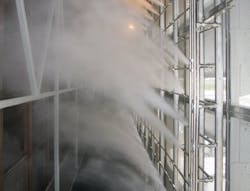University of Colorado CHP Case Study: Lowering the Carbon Footprint of Traditional Power
There are a great many technologies being advanced to lower emissions and reduce the overall carbon footprint. Green hydrogen, renewable energy, and battery storage tend to receive the bulk of attention.
All are valid. But due to the number of traditional power plants and combined heat and power plants (CHP) in existence and the lack of likelihood that they will all be shuttered anytime soon, these facilities represent another avenue that can lead towards the achievement of net-zero targets.
Take the case of the many facilities providing on-site power around the world. There are thousands of these plants, primarily operating on natural gas and steam, many of them decades old. According to Bruce Hedman, Managing Director and CHP Systems Accelerator Coordinator at Entropy Research, there is more than 80 GW of installed CHP capacity in the United States alone, amounting to more than 4,600 industrial and commercial facilities. This accounts for 7% of the nation’s generation capacity and 12% of total generation.
Three out of four of these installations harness natural gas. Based on these numbers, the average size of these plants is about 17.5 MW. Many CHP facilities, though, are a great deal larger than that average, particularly those operating gas turbines. Most on-site generators are very small and tend to run reciprocating engines. The same holds true in Europe. It boasts thousands of small CHP installations that provide around 12% of the continent’s total generation, according to a report by SmartCHP.
By upgrading existing CHP facilities, major reductions in emissions can be achieved, far less fuel would be required to achieve the same power output, and the cost of energy can be brought down.
Such upgrades can include:
· Changing out old turbines for more modern machines.
· Upgrading turbines to curtail emissions and raise efficiency.
· Implementing power augmentation and wet compression technologies to increase output on hot days and lower the carbon footprint.
Campus Upgrades
The University of Colorado in Boulder implemented all three strategies to improve the efficiency of its CHP facility as well as lower emissions. Originally built in 1992, the CHP system was an upgrade to the original district energy system for steam distribution that began operation in 1909.
The project boosted reliability and power quality, in addition to bringing about energy cost savings. That system was designed to export excess power to the grid under a 15-year Power Purchase Agreement (PPA) with a local utility. But the equation changed due to higher-than-expected operating expenses and the expiration of the PPA. That led the university to reevaluate the system to economically supply power for its own needs while reducing the campus’ carbon footprint.
The new CHP system had to operate at high reliability and availability as it served a campus of around 30,000 students spread across over 100 buildings amounting to around eight million square feet.
Turbine Upgrades
A series of upgrades were made to existing turbines as well as the introduction of new equipment. Two upgraded Mitsubishi MF111AB gas turbines each provided 15 MW of capacity. The exhaust gas is captured and fed into two heat recovery steam generators (HRSG), which provide the steam to power a new 2.5 MW condensing steam turbine as well as additional steam for district heating and cooling for the campus.
While the University of Colorado-Boulder had enough power for its entire needs, it elected to only operate one gas turbine at a time with the other on standby. To meet is summer peak demand of 20 MW, the local utility provided some power from the grid. The gas turbine typically ran at a base load of 10 MW. Its waste heat is captured to produce 40,000 pounds per hour of steam to generate additional power of 2.5 MW from the steam turbine.
At those times when the CHP system was not running due to maintenance, grid power fed the campus, and steam needs are met by two conventional boilers which have been retained onsite.
Adding More Power
Another aspect of the college’s CHP system upgrade was power augmentation achieved via inlet air fogging. This is a method of boosting performance, particularly during the hot summer months when turbine output can drop by as much as 40% depending on temperature, altitude, humidity, and pressure. By cooling the ambient air that is fed into the compressor, more power is generated. This is accomplished by spraying atomized water at high pressure into the inlet to cool the airflow. Power boosts of 10% are commonplace using this approach. A CHP plant with a capacity of 30 MW, then, would gain 3 MW or more from inlet air fogging. The University of Colorado-Boulder used inlet air fogging for decades.
Fogging systems from Mee Industries were installed on both Mitsubishi turbines. They operated with demineralized water at a pressure of 2000 psi. Two pump skids fed pressurized water to 32 fog nozzle manifolds that each have eight fog nozzles. These impaction pin nozzles with o-ring seals were made of type 316 stainless steel. Their 0.006-inch diameter orifice produced micro-fine fog droplets that cooled the inlet air. When turbine power output dropped during hot summer days, the MeeFog system provided additional capacity.
The effectiveness of wet compressions is based on the fact that a gas turbine’s compressor consumes half or more of the work produced by the expansion turbine. Therefore, an increase in compressor efficiency can produce a significant rise in the power output and fuel efficiency of a gas turbine. The added mass flow of water also causes a power increase. But this is small compared to the power boost resulting from the reduced work of compression.
Wet compression has been around for decades. NASA funded research into the use of water injection into aero engine compressors to reduce NOx emissions from commercial aircraft during takeoff. Such systems also reduce hot-section temperature for the same thrust, thus potentially decreasing engine maintenance costs. Similarly, wet compression has been found to boost power output and lower NOx emissions in gas turbines.
University Commitment
As a signatory to the American College and University Presidents’ Climate Commitment, University of Colorado-Boulder has operated on a carbon reduction plan for more than a decade. An integral part of this has been its repowered and upgraded CHP system, addition of renewable energy resources, and inlet air fogging.
About the author: Archie Robb is a freelance writer from Southern California focusing on business and technology.
About the Author
Archie Robb
Archie Robb is a freelance writer from Southern California focusing on business and technology.




